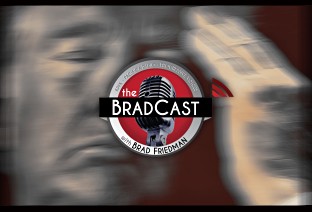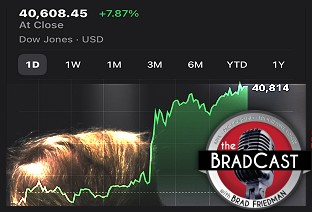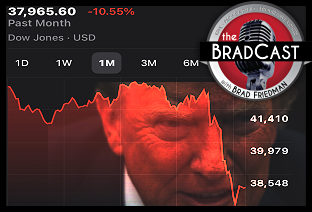 On today's BradCast: Honestly, I tried. But it was really hard to find any part of the case heard by the corrupted U.S. Supreme Court on Thursday that wasn't just absolutely ridiculous. [Audio link to full show follows this summary.]
On today's BradCast: Honestly, I tried. But it was really hard to find any part of the case heard by the corrupted U.S. Supreme Court on Thursday that wasn't just absolutely ridiculous. [Audio link to full show follows this summary.]
For nearly three hours this morning, the nine Justices themselves --- including a number of its rightwingers --- seemed to struggle to pretend that any of this made sense. In Trump v. United States [PDF], the disgraced four-time indictee is arguing that former Presidents of the United States have "absolute immunity" from any and all crimes they may have committed while serving in office, including murdering his political opponents or anything else you can think of.
As absurd as it sounds, Donald Trump has used this novel claim to, so far, successfully delay his federal trial on four criminal counts brought by Special Counsel Jack Smith related to Trump's many failed efforts to steal the 2020 Presidential election. SCOTUS has helped by delaying today's hearing for months and may help further depending on when they decide to release their opinion, and whether or not that opinion will lead to still more delays in the lower courts.
After losing this argument at the trial court last year and then unanimously at the D.C. Court of Appeals, Trump brought the case to SCOTUS, packed with three of his own appointees. They did him the favor of taking up his losing argument and putting off their Oral Argument on it until today, almost certainly delaying his trial for trying to steal the 2020 election until AFTER the 2024 election. [Transcript and audio of today's proceedings here.]
"This Court has never recognized absolute criminal immunity for any public official. Petitioner, however, claims that a former President has permanent criminal immunity for his official acts, unless he was impeached and convicted," argued Michael Dreeban, Counselor to Jack Smith, in his opening statement. "His novel theory would immunize former Presidents for criminal liability for bribery, treason, sedition, murder and, here, conspiring to use fraud to overturn the results of an election and perpetuate himself in power. Such Presidential immunity has no foundation in the Constitution."
In taking the case, the Court decided to hear the following question: "Whether and if so to what extent does a former President enjoy Presidential immunity from criminal prosecution for conduct alleged to involve official acts during his tenure in office."
But what "official acts" are they even talking about? Smith's indictment accuses Trump of things like organizing fake slates of electors; pressuring state officials and the DOJ and his Vice President to fraudulently change certified election results; and directing supporters to the Capitol on Jan. 6, 2021 after telling them to "fight like hell or we won't have a country anymore." The Justices --- as well as our two guests today --- all seemed to have a very difficult time finding any "official acts" for which Trump is being accused.
We're joined today by two excellent guests. Former Chief of the Fraud and Public Corruption unit at the U.S. Attorney's office in D.C., RANDALL D. ELIASON now teaches at George Washington University Law School, publishes the SidebarsBlog newsletter, and contributes to New York Times. Former Deputy Asst. Attorney General at DoJ, LISA GRAVES is now Executive Director of Truth North Research. They each know far more about all of this and the specifics of the Rule of Law than I do. But they too had trouble coming up with much of anything Trump has been charged with that has anything to do with "official acts" as President.
Its an "astonishing argument," says Graves. "What's at issue in this case is a set of conduct by this President to basically subvert our democracy through a variety of means. None of these are official acts. But even if somehow a President were engaged in an 'official act,' like appointing an ambassador, he couldn't take a bribe in the context of doing so. It just seems crazy that here we are with the U.S. Supreme Court basically delaying the prosecution of Donald Trump for a set of acts that are clearly outside the bounds of a Commander-in-Chief, whose job is to take care that the law is faithfully executed."
There was no conflict in the lower courts to resolve, but at least four members of the High Court decided they wanted to hear this silly argument nonetheless in which Trump and his attorney John Sauer have been arguing that, without immunity, Presidents would be unable to take bold, decisive action. It would "chill" their ability to do their job for the American people.
"The easiest response is that for nearly 250 years, that hasn't deterred Presidents from taking bold, decisive action," Eliason responds today. "Because they've also been willing to recognize that they need to act in compliance with federal criminal law, and they might be held accountable if they don't. On the one hand, he's saying there's a chilling effect on all these Presidents, even though it hasn't bothered any President in the past. On the other hand, he's saying 'But of course he could be prosecuted IF he's impeached and removed.' Well there's a chilling effect. So why doesn't that undercut his argument?"
We share audio clips from today's hearing, along with much more insight on all of it from Eliason and Graves, including why this case was accepted in the first place; the "Bizarro Superman world" in which we are having this argument and the "repugnant" idea of Clarence Thomas sitting on this case at all, as Graves observes; the argument by Sauer that unless statutes specifically say they are to apply to the President, like the federal bribery statute, they can't be held against him (Eliason, who headed up the DOJ's bribery prosecutions unit in D.C., notes the bribery statute actually "does not name the President, but nobody thinks that the President is immune for bribery"); and, of course, how and when they believe the Court will ultimately rule.
ALSO TODAY... On Wednesday, a grand jury in Arizona indicted Trump's former Chief of Staff Mark Meadows, his attorney Rudy Giuliani, his other attorney John Eastman and 15 others, including 11 Republican fake electors (including two sitting state Senators and the former head of the state GOP), for their efforts to try and steal the 2020 election for Trump in the state.
AND FINALLY... Desi Doyen joins us for our latest Green News Report, with grim-as-ever news, but also some really cool news from out here in California, where the state has been powered by 100% renewable energy --- largely solar --- for much or all of the day for a whole bunch of days in a row in recent weeks. So, there's that positive note to end today with, in any event!...
(Snail mail support to "Brad Friedman, 7095 Hollywood Blvd., #594 Los Angeles, CA 90028" always welcome too!)
|


 'Green News Report' 5/1/25
'Green News Report' 5/1/25
 100 Daze:
100 Daze: Campaign to 'Impeach Trump Again' Gains Fresh Momentum: 'BradCast' 4/29/25
Campaign to 'Impeach Trump Again' Gains Fresh Momentum: 'BradCast' 4/29/25 'Green News Report' 4/29/25
'Green News Report' 4/29/25 And Then They Came for the Judges...: 'BradCast' 4/28/25
And Then They Came for the Judges...: 'BradCast' 4/28/25 Sunday 'Desperation' Toons
Sunday 'Desperation' Toons Trump EPA Guts Enviro Justice Office: 'BradCast' 4/24/25
Trump EPA Guts Enviro Justice Office: 'BradCast' 4/24/25 'Green News Report' 4/24/25
'Green News Report' 4/24/25 Nation's Largest Broadcaster Hoaxes Viewers to Help Gut FCC Rules: 'BradCast' 4/23/25
Nation's Largest Broadcaster Hoaxes Viewers to Help Gut FCC Rules: 'BradCast' 4/23/25 Trump's FCC on Precipice of Ending All Limits on Corporate Control of Local TV Stations
Trump's FCC on Precipice of Ending All Limits on Corporate Control of Local TV Stations GOP Earth Day 2025 Hypocrisies and Dilemmas: 'BradCast' 4/22/25
GOP Earth Day 2025 Hypocrisies and Dilemmas: 'BradCast' 4/22/25 'Green News Report' 4/22/25
'Green News Report' 4/22/25 Pope Francis Dies, Trump Still Alive and Criming: 'BradCast' 4/21/25
Pope Francis Dies, Trump Still Alive and Criming: 'BradCast' 4/21/25 Sunday
Sunday  Sunday 'Zero Day' Toons
Sunday 'Zero Day' Toons 'Green News Report' 4/10/25
'Green News Report' 4/10/25 Soc. Sec. Expert Warns DOGE of Collapse, Privatization: 'BradCast' 4/10/2025
Soc. Sec. Expert Warns DOGE of Collapse, Privatization: 'BradCast' 4/10/2025 Trump Blinks, Chaos Reigns, Markets Spike Amid Tariff 'Pause': 'BradCast' 4/9/25
Trump Blinks, Chaos Reigns, Markets Spike Amid Tariff 'Pause': 'BradCast' 4/9/25 SCOTUS Deportation Ruling Grimmer Than First Appears: 'BradCast' 4/8/25
SCOTUS Deportation Ruling Grimmer Than First Appears: 'BradCast' 4/8/25 Cliff Diving with Donald: 'BradCast' 4/7/25
Cliff Diving with Donald: 'BradCast' 4/7/25 'Mob Boss' Trump's Trade Sanctions Tank U.S., World Markets: 'BradCast' 4/3/25
'Mob Boss' Trump's Trade Sanctions Tank U.S., World Markets: 'BradCast' 4/3/25 Crawford Landslide in WI; Booker Makes History in U.S. Senate: 'BradCast' 4/2/25
Crawford Landslide in WI; Booker Makes History in U.S. Senate: 'BradCast' 4/2/25 Judge Ends Challenge to GA's Unverifiable, Insecure Vote System: 'BradCast' 4/1/25
Judge Ends Challenge to GA's Unverifiable, Insecure Vote System: 'BradCast' 4/1/25 Bad Court, Election News for Trump is Good News for U.S.: 'BradCast' 3/31
Bad Court, Election News for Trump is Good News for U.S.: 'BradCast' 3/31
 VA GOP VOTER REG FRAUDSTER OFF HOOK
VA GOP VOTER REG FRAUDSTER OFF HOOK Criminal GOP Voter Registration Fraud Probe Expanding in VA
Criminal GOP Voter Registration Fraud Probe Expanding in VA DOJ PROBE SOUGHT AFTER VA ARREST
DOJ PROBE SOUGHT AFTER VA ARREST Arrest in VA: GOP Voter Reg Scandal Widens
Arrest in VA: GOP Voter Reg Scandal Widens ALL TOGETHER: ROVE, SPROUL, KOCHS, RNC
ALL TOGETHER: ROVE, SPROUL, KOCHS, RNC LATimes: RNC's 'Fired' Sproul Working for Repubs in 'as Many as 30 States'
LATimes: RNC's 'Fired' Sproul Working for Repubs in 'as Many as 30 States' 'Fired' Sproul Group 'Cloned', Still Working for Republicans in At Least 10 States
'Fired' Sproul Group 'Cloned', Still Working for Republicans in At Least 10 States FINALLY: FOX ON GOP REG FRAUD SCANDAL
FINALLY: FOX ON GOP REG FRAUD SCANDAL COLORADO FOLLOWS FLORIDA WITH GOP CRIMINAL INVESTIGATION
COLORADO FOLLOWS FLORIDA WITH GOP CRIMINAL INVESTIGATION CRIMINAL PROBE LAUNCHED INTO GOP VOTER REGISTRATION FRAUD SCANDAL IN FL
CRIMINAL PROBE LAUNCHED INTO GOP VOTER REGISTRATION FRAUD SCANDAL IN FL Brad Breaks PA Photo ID & GOP Registration Fraud Scandal News on Hartmann TV
Brad Breaks PA Photo ID & GOP Registration Fraud Scandal News on Hartmann TV  CAUGHT ON TAPE: COORDINATED NATIONWIDE GOP VOTER REG SCAM
CAUGHT ON TAPE: COORDINATED NATIONWIDE GOP VOTER REG SCAM CRIMINAL ELECTION FRAUD COMPLAINT FILED AGAINST GOP 'FRAUD' FIRM
CRIMINAL ELECTION FRAUD COMPLAINT FILED AGAINST GOP 'FRAUD' FIRM RICK SCOTT GETS ROLLED IN GOP REGISTRATION FRAUD SCANDAL
RICK SCOTT GETS ROLLED IN GOP REGISTRATION FRAUD SCANDAL VIDEO: Brad Breaks GOP Reg Fraud Scandal on Hartmann TV
VIDEO: Brad Breaks GOP Reg Fraud Scandal on Hartmann TV RNC FIRES NATIONAL VOTER REGISTRATION FIRM FOR FRAUD
RNC FIRES NATIONAL VOTER REGISTRATION FIRM FOR FRAUD EXCLUSIVE: Intvw w/ FL Official Who First Discovered GOP Reg Fraud
EXCLUSIVE: Intvw w/ FL Official Who First Discovered GOP Reg Fraud GOP REGISTRATION FRAUD FOUND IN FL
GOP REGISTRATION FRAUD FOUND IN FL


























 The court takes Wednesdays off in Donald Trump's New York criminal trial on 34 felony counts related to his use of hush-money paid to a porn star to help him cheat his way to winning the 2016 Presidential election. So, today is a good opportunity for us here on
The court takes Wednesdays off in Donald Trump's New York criminal trial on 34 felony counts related to his use of hush-money paid to a porn star to help him cheat his way to winning the 2016 Presidential election. So, today is a good opportunity for us here on  During opening statements in the disgraced former President's ongoing criminal trial, prosecutors argued the scheme surrounding his hush-money payments to a porn star just before the 2016 election amounted to "election fraud, pure and simple." Similar fraud since then, by Trump and now much of his Republican party, pervades many of our stories on today's
During opening statements in the disgraced former President's ongoing criminal trial, prosecutors argued the scheme surrounding his hush-money payments to a porn star just before the 2016 election amounted to "election fraud, pure and simple." Similar fraud since then, by Trump and now much of his Republican party, pervades many of our stories on today's  Nothing but huge news --- all of several different sorts --- on today's
Nothing but huge news --- all of several different sorts --- on today's  You may be happy to know we don't begin today's
You may be happy to know we don't begin today's  On today's
On today's  Even Joe Biden is now
Even Joe Biden is now  After a number of quick news headline since our previous
After a number of quick news headline since our previous  Desperate times, desperate measures and all that that entails on today's
Desperate times, desperate measures and all that that entails on today's  And we thought the real news sites were bad enough. Now, as discussed on today's
And we thought the real news sites were bad enough. Now, as discussed on today's  Keep hope alive. We've got a bunch of mostly good news stories for you on today's
Keep hope alive. We've got a bunch of mostly good news stories for you on today's  The warnings came from safety experts, insurance companies and environmentalists. Years ago. So, of course, they were all ignored by both the then Republican Governor and big business, including Big Oil, who all got their way over safety concerns and the public interest, as discussed on today's
The warnings came from safety experts, insurance companies and environmentalists. Years ago. So, of course, they were all ignored by both the then Republican Governor and big business, including Big Oil, who all got their way over safety concerns and the public interest, as discussed on today's  It was yet another busy news day and, thus, it was another very busy
It was yet another busy news day and, thus, it was another very busy  On today's
On today's  As it
As it 












